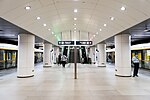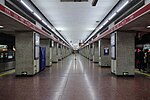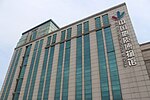Fuchengmen

Fuchengmen (simplified Chinese: 阜成门; traditional Chinese: 阜成門; pinyin: Fùchéngmén; Manchu:ᡝᠯᡤᡳᠶᡝᠨ ᡳᠮᡠᡨᡝᡥᡝᡩᡠᡴᠠ;Möllendorf:elgiyen i mutehe duka), formerly known as Pingze Gate, was a gate on the western side of Beijing's city wall. The gate was torn down in the 1960s, and has been replaced by the Fuchengmen overpass on the 2nd Ring Road. Even though it has been destroyed, it is still used as a place name. Fuchengmen Station is a transportation node, where a number of public buses and Line 2 of the Beijing Subway stop. The street that once passed through the gate is still named in its relation to the gate. East of Fuchengmen, it is known as Fuchengmen Inner Street because it would have been inside the wall. West of Fuchengmen, it is known as Fuchengmen Outer Street. Further west, the street becomes Fushi Road (China National Highway 109).
Excerpt from the Wikipedia article Fuchengmen (License: CC BY-SA 3.0, Authors, Images).Fuchengmen
阜成门南大街, Xicheng District Jinrongjie (首都功能核心区)
Geographical coordinates (GPS) Address Nearby Places Show on map
Geographical coordinates (GPS)
| Latitude | Longitude |
|---|---|
| N 39.922222222222 ° | E 116.35 ° |
Address
阜成门桥
阜成门南大街
100032 Xicheng District, Jinrongjie (首都功能核心区)
Beijing, China
Open on Google Maps










